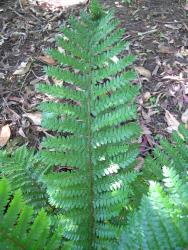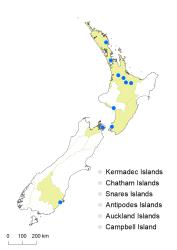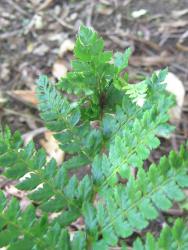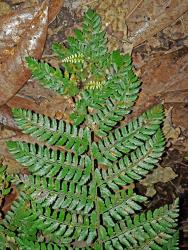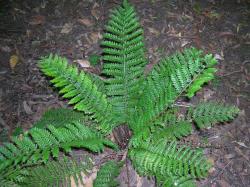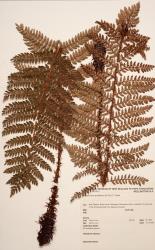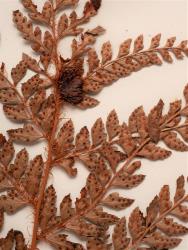- ≡ Aspidium proliferum R.Br., Prodr. Fl. Nov. Holland. 147 (1810)
- ≡ Hypopeltis prolifera (R.Br.) Bory in Bélanger, Voy. Indes Or., Bot. 67 (1833)
- ≡ Polystichum aculeatum var. proliferum (R.Br.) Domin, Biblioth. Bot. 20(85): 54 (1913)
Rhizomes erect, densely scaly. Rhizome scales ovate to narrowly ovate, 16–20 mm long, 2.5–6 mm wide, bicolorous with dark centres and pale margins, margins ciliate; scales at the base of the stipe much narrower, 0.5–0.6 mm wide. Fronds 540–900 mm long. Stipes 120–350 mm long, dark brown proximally, pale brown distally, abundantly scaly throughout; scales narrowly ovate to ovate, bicolorous with dark centres and paler margins, apices acuminate, margins entire. Rachises yellow-brown, sulcate, not winged, bearing 1–3 bulbils near the apices; abundantly scaly; scales on abaxial surface narrowly ovate and bicolorous, gradually replaced distally by narrowly ovate to ± linear pale brown scales. Laminae 2–3-pinnate, narrowly elliptic, 340–740 mm long, 80–270 mm wide, dark green adaxially, paler green abaxially, coriaceous, bearing abundant pale brown scales on abaxial costae and lamina surfaces, sparsely scaly on adaxial costae, ± glabrous on adaxial lamina surfaces. Primary pinnae in 25–35 pairs below short pinnatifid apex, slightly overlapping to narrowly spaced, narrowly ovate or narrowly elliptic, rarely bearing bulbils near the apices; the longest at or near the middle, 60–135 mm long, 18–35 mm wide, apices acute or acuminate, bases stalked; costae narrowly winged distally. Longest secondary pinnae oblong or ovate with an expanded basal acroscopic lobe, 9–18 mm long, 4–10 mm wide, apices sharply pointed, bases stalked, margins serrate or deeply divided; a single basal acroscopic tertiary pinna or pair of pinnae often produced proximally on the proximal secondary pinnae, elliptic, up to 6 mm long and 3 mm wide. Sori round, medial; indusia round, 0.5–0.6 mm diameter, with a conspicuous dark central area.
Polystichum proliferum is distinguished from most other New Zealand species of the genus by the presence of 1–3 bulbils on the rachis near the frond apex. It is similar in this regard to P. lentum, but the laminae are more divided, with several stalked secondary pinnae produced along the length of the primary pinnae. In P. lentum the primary pinnae are often deeply divided, but only bear a single stalked secondary pinna on each primary pinna.
The fronds of P. proliferum are most similar in general appearance to those of P. vestitum, and bear bicolorous scales on the stipes and rachises. However, the presence of bulbils on the rachis, and the indusia with dark centres, distinguish P. proliferum from P. vestitum.
North Island: Northland, Auckland, Volcanic Plateau, Southern North Island.
South Island: Sounds-Nelson, Otago.
Altitudinal range: 0–60 m.
Polystichum proliferum is naturalised in a few places from Whangārei to the shores of Cook Strait, and in Dunedin.
It occurs naturally in Australia (New South Wales, Victoria, Tasmania; Jones 1998).
Polystichum proliferum occurs in disturbed habitats and has been recorded under scrub, on bush margins, on roadside clay banks, on old dunes under Eucalyptus, on wetland margins under willows, under Pinus radiata, and amongst blackberry and bracken.
Field (1890). Voucher WELT P015841, 1850.



